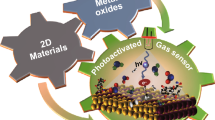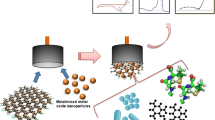Abstract
This paper reports on the creation of a new composite sensor material for detecting molecular oxygen, in which the fluorescent indicator, Pt (II) 5,10,15,20-tetrakis(2,3,4,5,6-pentafluorophenyl)-porphyrin, is adsorbed on mesoporous silica particles distributed in a fluorinated polymer performing the functions of the gas transmission line and protection against leaching. A set of methods is used to determine the optimal conditions for the monolayer adsorption of the dye. It is found that unwanted multilayer adsorption with the formation of dimers begins when the ratio of the diameter of the average adsorption center to the average diameter of the indicator molecule is less than three. An original method is applied for the encapsulation of microparticles with the formation of a surface salt of fluorinated surfactants, which protect the material at the manufacturing stage before its deposition to the substrate. It is shown that the material has a linear calibration dependence in a range from 0 to 40°C, a response time in the gas phase of less than 10 s, and photostability sufficient to function as an oxygen sensor for at least a year.






Similar content being viewed by others
REFERENCES
D. B. Papkovsky and R. I. Dmitriev, Quenched-Phosphorescence Detection of Molecular Oxygen: Applications in Life Sciences (R. Soc. Chem., UK, 2018).
O. S. Wolfbeis, “Luminescent sensing and imaging of oxygen: fierce competition to the Clark electrode,” BioEssays 37, 921–928 (2015).
I. Ahmed, H. Lin, L. Zou, A. L. Brody, I. M. Qazi, L. Lv, T. R. Pavase, M. U. Khan, S. Khan, and L. Sun, “An overview of smart packaging technologies for monitoring safety and quality of meat and meat products,” Packag. Technol. Sci. 31, 449–471 (2018).
N. K. Zaitsev, A. A. Zharov, P. V. Mel’nikov, and A. E. Kozhukhova, “Rapid procedure for measuring oxygen concentration in aqueous, non-aqueous and gaseous media,” Zavod. Lab., Diagn. Mater. 83 (9), 9–14 (2017).
W. Feng, N. Zhou, L. Chen, and B. Li, “An optical sensor for monitoring of dissolved oxygen based on phase detection,” J. Opt. 15, 055502 (2013).
O. S. Wolfbeis, “Materials for fluorescence-based optical chemical sensors,” J. Mater. Chem. 15, 2657–2669 (2005).
M. Quaranta, S. M. Borisov, and I. Klimant, “Indicators for optical oxygen sensors,” Bioanal. Rev. 4, 115–157 (2012).
Ch.-Sh. Chu and Yu-L. Lo, “High-performance fiber-optic oxygen sensors based on fluorinated xerogels doped with Pt(II) complexes,” Sens. Actuators, B 124, 376–382 (2007).
Ch.-Sh. Chu and Ch.-A. Lin, “Optical fiber sensor for dual sensing of temperature and oxygen basedon PtTFPP/CF embedded in sol–gel matrix,” Sens. Actuators, B 195, 259–265 (2014).
J. M. Bolivar, S. Schelch, T. Mayr, and B. Nidetzky, “Mesoporous silica materials labeled for optical oxygen sensing and their application to development of a silica-supported oxidoreductase biocatalyst,” ACS Catal. 5, 5984–5993 (2015).
K. H. Chae, D. W. Hong, M. K. Lee, O. J. Son, and J. I. Rhee, “Anti-fouling sol–gel-derived sensing membrane entrapped with polymer containing phosphorylcholine groups for an optical O2 sensor application,” Sens. Actuators, B 173, 636–642 (2012).
Z. Hongbin and C. Mu, “Anti-fouling coatings of poly(dimethylsiloxane) devices for biological and biomedical applications,” J. Med. Biol. Eng. 35, 143–155 (2015).
P. Zhu, W. Meng, and Y. Huang, “Synthesis and antibiofouling properties of crosslinkable copolymers grafted with fluorinated aromatic side chains,” RSC Adv. 7, 3179–3189 (2017).
D. B. Papkovsky and R. I. Dmitriev, “Biological detection by optical oxygen sensing,” Chem. Soc. Rev. 42, 8700–8732 (2013).
J. Ehgartner, M. Strobl, J. M. Bolivar, D. Rabl, M. Rothbauer, P. Ertl, S. M. Borisov, and T. Mayr, “Simultaneous determination of oxygen and pH inside microfluidic devices using core-shell nanosensors,” Anal. Chem. 88, 9796–9804 (2016).
J. Ehgartner, P. Sulzer, T. Burger, A. Kasjanow, D. Bouwes, U. Kruhne, I. Klimant, and T. Mayr, “Online analysis of oxygen inside silicon-glass microreactors withintegrated optical sensors,” Sens. Actuators, B 228, 748–757 (2016).
P. Lehner, C. Staudinger, S. M. Borisov, and I. Klimant, “Ultra-sensitive optical oxygen sensors for characterization of nearly anoxic systems,” Nat. Commun. 5, 4460 (2014).
N. K. Zaitsev, P. V. Melnikov, V. A. Alferov, A. V. Kopytin, and K. E. German, “Stable optical oxygen sensing material based on perfluorinated polymer and fluorinated platinum(II) and palladium(II) porphyrins,” Proc. Eng. 168, 309–312 (2016).
B. J. Muller, T. Burger, S. M. Borisov, and I. Klimant, “High performance optical trace oxygen sensors based on NIR-emittingbenzoporphyrins covalently coupled to silicone matrixes,” Sens. Actuators, B 216, 527–534 (2015).
K. Koren, S. M. Borisov, and I. Klimant, “Stable optical oxygen sensing materials based on click-coupling of fluorinated platinum(II) and palladium(II) porphyrins—a convenient way to eliminate dye migration and leaching,” Sens. Actuators, B 169, 173–181 (2012).
A. P. Antropov, A. V. Ragutkin, P. V. Melnikov, and N. K. Zaitsev, “Composite material for optical oxygen sensor,” IOP Conf. Ser.: Mater. Sci. Eng. 289, 012031 (2018).
N. A. Kuznetsova, O. A. Yuzhakova, A. S. Kozlov, A. A. Krasnovskii, M. G. Strakhovskaya, and O. L. Kaliya, “Effect of support-pore size on activity of heterogeneous photosensitizer based on phthalocyanine covalently grafted to aminopropylated silica gel,” Nanotechnol. Russ. 8, 122–128 (2013).
H. Valimaki, J. Verho, J. Kreutzer, D. K. Rajan, T. Ryynanen, M. Pekkanen-Mattila, A. Ahola, K. Tappura, P. Kallio, and J. Lekkala, “Fluorimetric oxygen sensor with an efficient optical read-out forin vitro cell models,” Sens. Actuators, B 249, 738–746 (2017).
A. V. Vannikov and A. D. Grishina, “The photorefractive effect in polymeric systems,” Russ. Chem. Rev. 72, 471–488 (2003).
A. M. Buckley and M. Greenblatt, “The sol–gel preparation of silica gels,” J. Chem. Educ. 71, 599–602 (1994).
M. Besbes, N. Fakhfakh, and M. Benzina, “Characterization of silica gel prepared by using sol–gel process,” Phys. Proc. 2, 1087–1095 (2009).
B. K. Zuev, R. V. Novichkov, E. O. Aleksandrova, and A. Yu. Olenin, “Preparation and study of the surface-layer composition of chemically modified silica nanoparticles,” Nanotechnol. Russ. 10, 53–59 (2015).
N. K. Zaitsev, V. I. Dvorkin, P. V. Melnikov, and A. E. Kozhukhova, “A dissolved oxygen analyzer with an optical sensor,” J. Anal. Chem. 73, 102–108 (2018).
K. Korena, L. Huttera, B. Enko, A. Pein, S. M. Borisov, and I. Klimant, “Tuning the dynamic range and sensitivity of optical oxygen-sensors by employing differently substituted polystyrene-derivatives,” Sens. Actuators, B 176, 344–350 (2013).
A. A. Isakova, A. V. Safonov, A. Yu. Alexandrovskaya, T. B. Galushko, A. V. Indenbom, and B. V. Spitsyn, “The effect of nanodiamond surface modification on interaction with pseudomonas putida K12,” Prot. Met. Phys. Chem. Surf. 53, 220–223 (2017).
ACKNOWLEDGMENTS
This study was supported by a grant from the Russian Science Foundation (project no. 17-79-10439).
Author information
Authors and Affiliations
Corresponding author
Additional information
Translated by V. A. Alekseev
Rights and permissions
About this article
Cite this article
Melnikov, P.V., Naumova, A.O., Alexandrovskaya, A.Y. et al. Optimizing Production Conditions for a Composite Optical Oxygen Sensor Using Mesoporous SiO2. Nanotechnol Russia 13, 602–608 (2018). https://doi.org/10.1134/S1995078018060083
Received:
Accepted:
Published:
Issue Date:
DOI: https://doi.org/10.1134/S1995078018060083




